Essential
The essential oil of Wintergreen is well known for its unique ability to ease muscular pains in Europe. Thanks to its specific chemical composition (it has a large proportion of methyl salicylate), it is unsurprising that Wintergreen features in many products for athletes. Sadly, deeper investigations rapidly bring to light some confusing information which likely drives the suspicions of fraud related to this oil.
Wintergreen oil, essence for sportsmen
1. Essential oil of Wintergreen
1.1 Composition of the oil for massage
1.2 Extraction of the essence of Gaultheria
2. Wintergreen plants
2.1 Gaultheria pocumbens
2.2 Gaultheria fragrantissima
3. Wintergreen oil in aromatherapy
3.1 Differences between the French and Anglo-Saxon aromatherapy world in relation to Wintergreen
3.2 Note and blends
3.3 How to use Wintergreen oil?
3.4 Wintergreen for tendinitis or rheumatism
3.5 Surprising other ways to use Wintergreen oil
4. How much does Wintergreen oil cost?
5. Conclusion
- Remerciements
- Resources
- Very Essential People
- Disclaimer
- Pictures
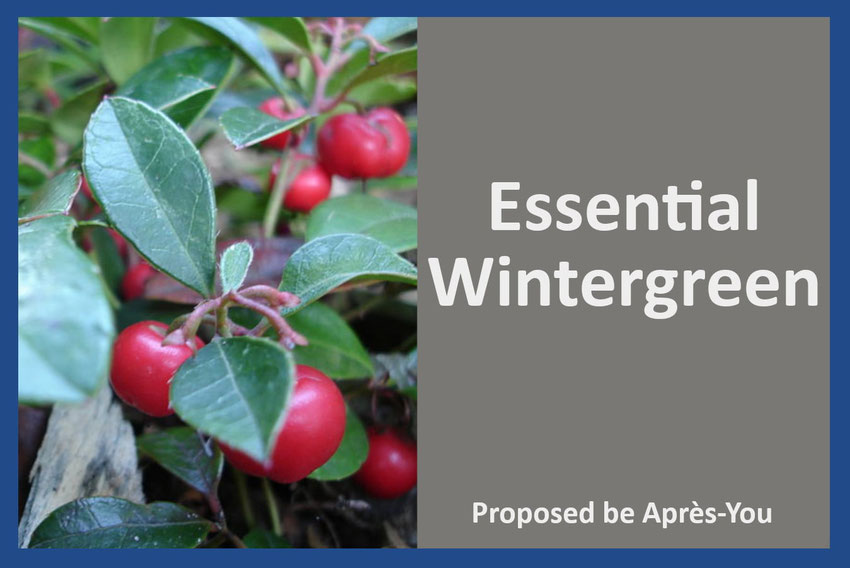
1. Essential oil of Wintergreen
1.1 Composition of the oil for massage
If you have a bit of experience with essential oil chemistry, you know that most oils are made of several hundred molecules.
In the case of Wintergreen, its composition is quite unique; one single molecule can account for up to 99% of the oil. This molecule–methyl salicylate–is similar to another one that most of us know: acetylsalicylate.
Doesn’t ring a bell? I assure you that you are likely very familiar with acetylsalicylate!
Acetylsalicylate is the molecule found in Aspirin.
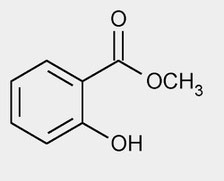
The methyl salicylate molecule which it resembles has been synthesized for use in many industries, including as an antiseptic in mouthwash liquid, as a fragrance to mask odors, as weapons for chemical warfare weapons, and to attract bees for scientific research (1).
In aromatherapy, however, the main recognized application of this molecule (and, by extension, of Wintergreen oil) is to relieve muscle pain.
1.2 Extraction of the essential of Gaultheria
The process of extracting this ‘single-molecule oil’ is different from that of most other oils.
Although the extraction process still involves distillation, to facilitate obtaining the maximum amount of methyl salicylate possible, the Wintergreen leaves must first be soaked in hot water for at least one night. It is only after this step that the distillation process begins. Distillation will last up to five hours.
It is a demanding process because only up to 1% of the raw material is finally concentrated in essential oil, 100 kg of leaves is needed to get 1 kg of essential oil.

Essential oil of Wintergreen is particular in one other way concerning the distillation process. Like Clove oil, the density of essential oil of Wintergreen ranges between 1.175 à 1.190 g/mL (2). This means that the essential oil of Wintergreen is heavier than water.
It also means that the separation of the essential oil and the hydrosol after the extraction process is different from the norm. For this reason, distilling heavy essential oils like Wintergreen requires special equipment.
2. Wintergreen plants
Thus far, I have referred to ‘Wintergreen’ in the singular sense. However, to be entirely accurate, I should be referring to ‘Wintergreens’ plural. In aromatherapy, two different kinds of Wintergreen are used.
To understand the differences between them, one has to learn a bit about the species used to produce these essential oils:
- Gaultheria pocumbens (6) is originally from North America
- Gaultheria fragrantissima from China/Nepal
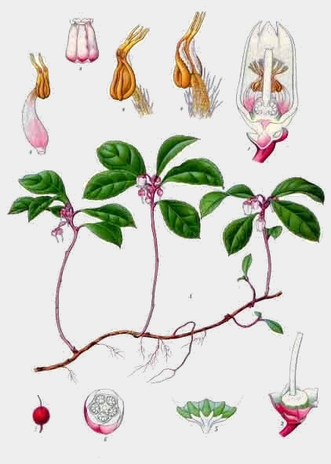
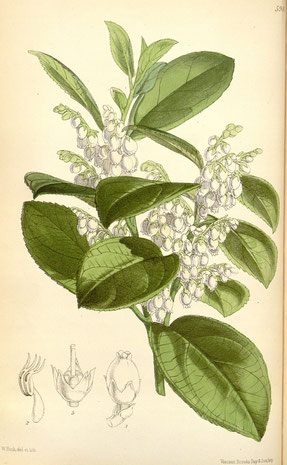
Did you know?
The French name for Wintergreen ‘Gaulthérie’ comes from the name of the French-Canadian botanist and doctor, Jean-François Gaulthier (1708 - 1756), who discovered the essential oil of Wintergreen (7).
2.1 Gaultheria pocumbens
Gaultheria pocumbens is a small shrub that shares the same family as the blueberry (Ericaceae). Native Americans used to chew the leaves to calm fevers or to calm physical pain (7).
American Wintergreen has red small berries and is known under several other names, such as ‘checkerberry’, ‘boxberry’, and ‘teaberry’. The latter sobriquet dates from the American War of Independence when the rebellious colonists made use of the leaves of Wintergreen to replace Chinese tea (8).

2.2 Gaultheria fragrantissima
Asian Wintergreen–Gaultheria fragrantissima–has white to light purple fruits. The shrub can be up to 2 meters high and grows in altitudes between 1500 and 2700 m.a.s.l (9)
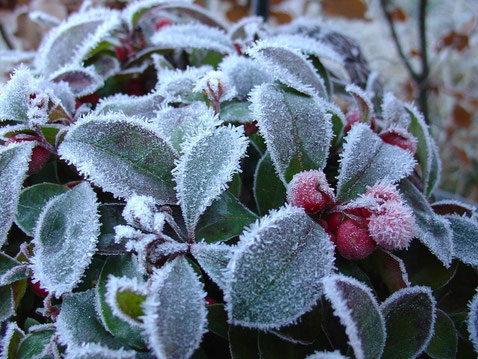
Interestingly, the family of Gaultheria includes around 135 species (10), of which one is also used in traditional Chinese medicine to fight arthritis and pain (11).
3. Wintergreen oil in aromatherapy
3.1 Differences between the French and Anglo-Saxon aromatherapy world in relation to Wintergreen
In the French aromatherapy world, the distinction between these two types of Wintergreen is pretty straightforward (at least in theory!), as the two types are known under different names (2):
- Gaulthérie couchée refers to Gaultheria pocumbens (that we can translate by “lying Wintergreen”).
- Gaulthérie odorante for the second one (that we can translate into “smelly Wintergreen”). Also sometimes sold as ‘Indian Wintergreen’ or ‘Gandhapura oil’.
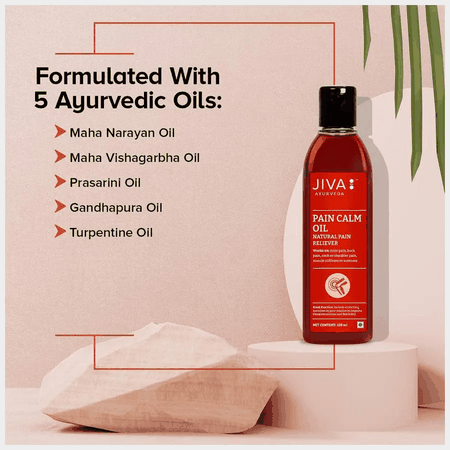
Both the two oils described above are thought to have similar properties supporting the ease of muscle pain. This may be one reason for the fact that in the English-speaking aromatherapy world they often do not differentiate between American and Asian Wintergreen.
Within French aromatherapy, this distinction is maintained, also to the point at which some French merchants specifically list the two essential oils separately in their merchandising catalogs.
Theoretically, it is simple but, sometimes, the two different essential oils both come from Asia…
Which is often a source of confusion and doubt regarding the origin or viability of the oils themselves.
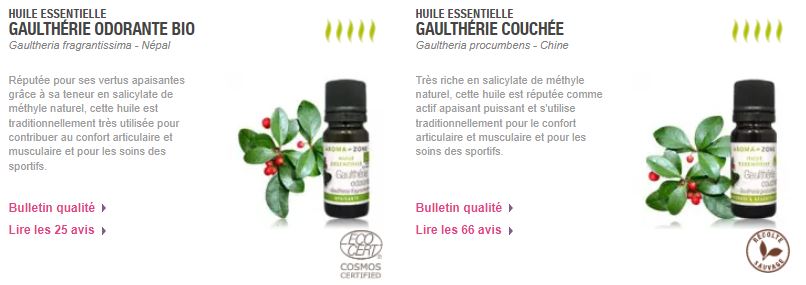
If you are looking for a specific essential oil of Wintergreen, it seems that the best means of differentiating between the two listed above is to examine the composition of the oils.
Asian Wintergreen (Gaultheria fragrantissima)from Nepal/China has a percentage of methyl salicylate that is closer to 65% (12).
Whereas (Gaultheria pocumbens) from North America has a percentage that is closer to 90% (13). Unfortunately, this rule of thumb does not always apply.
In actuality, compositions of both of these oils can approach 90% or more...
3.2 Note and blends
Wintergreens produce colorless aromatic oils that are pretty strong and are characterized by refreshing, slightly sweet, and minty notes.
Wintergreens’ strong and powerful scents are uplifting.
The strong and green note which characterizes Wintergreen is not recommended for diffusion (see the article about which oil to diffuse).
For this reason, Wintergreen has been used in many food products, e.g. for flavoring tea, candies, root beer, and ice cream.
Many people’s first contact with Wintergreen came through chewing gum.
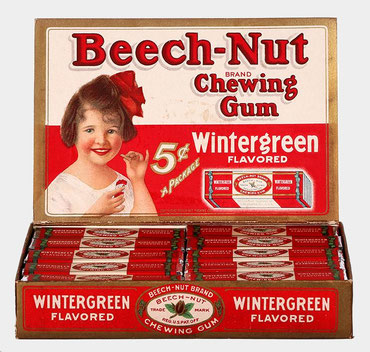
Blend idea:
The scent of Wintergreen oil can be very strong.
You can blend this oil with Cypress oil to give a nicer note.
It is also to mix the oil of the athlete with the aromatic oil of Ylang-ylang to add a more floral note and add a very calming effect.
3.3 How to use Wintergreen oil?
The different uses of Wintergreen oil in food products are strictly regimented. So, we do not recommend experimenting with flavoring your foods with Wintergreen.
As a rule, Après-You does not recommend the ingestion of essential oils. This is doubly applicable about this oil. Diluting Wintergreen in a carrier oil at a proper dilution rate, and applying it in massage is the best way to use this ‘one molecule oil’.
Recommendation and dilution rate
As a rule, essential oil of Wintergreen is not recommended to be used,
- in diffusion
- in ingestion,
- for people taking anticoagulant treatment or allergic to Aspirine.
We also recommend that children and pregnant and breastfeeding women refrain from using it.
On the other hand, if you are an adult and you have no particular health problem, Wintergreen is used in a massage at a maximum dilution of 20%.
3.4 Wintergreen for tendinitis or rheumatism
It is an oil that has interesting and proven potential for everything related to muscle or joint pain.
It also can be used to relieve tendinitis problems by adding a few drops to a cataplasm of green clay for example.
It can also be combined with Lemon Eucalyptus (Corymbia citriodora) and Katafray (Cedrelopsis grevei) to relieve joints sensitive to rheumatism.
3.5 Surprising other ways to use Wintergreen oil
Wintergreen oil is also used as a flavoring agent for some medicines or as well as some snus (a famous American snus brand called ‘Copenhagen’ has a dedicated product called ‘Wintergreen’ flavored with what is billed as ‘teaberry extract’).
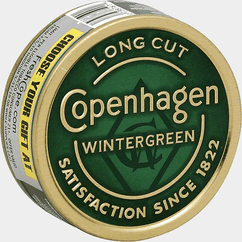
Another surprising use for Wintergreen oil is in the restoration of old rubber tubes. While it may at first sound odd to join together aromatherapy and motorcycle restoration, as you can see from the video, it seems that this aromatic oil has effective uses far beyond limiting muscle pain!
4. How much does Wintergreen oil cost?
In May 2022, Après-You conducted a price study on wintergreen essential oil.
The selected resellers are from different countries (USA, England, France Denmark...) with different distribution channels (direct sales, Amazon, MLM...).
To facilitate the comparison between all the brands and the volumes of the bottles offered, Après-You has converted the prices of all the resellers into Euros for 10 ml bottles.

One can notice a very wide heterogeneity of the prices practiced.
They range from simple to almost eightfold!
Of course, the distribution system used as well as taxes can influence retail prices.
It is still hard to believe that these two factors are the only ones to explain such large differences between the cheapest oil and the most expensive.
5. Conclusion
It is easy to fall down a research rabbit hole–especially with regards to Wintergreen–insofar as information can be unclear and/or contradictory. However, if you consider that:
- A single molecule (methyl salicylate) can sometimes compose up to 99% of the composition of a drop
- This molecule is recognized to have great properties for easing muscle pain.
- This molecule can be synthesized at a low price.

- While the distillation process demands a lot of raw martial, the extraction yield is hardly higher than 1% (3).
- The extraction process needs specific material to separate the oil from the hydrosol
- Currently, there is a positive forecast for the use of this aromatic oil, especially for massage. The market for Wintergreen oil is expected to rise to almost 300,000 tons by 2026 (4).
It is difficult to say if the oil you have at home is pure. While there are methods for checking the quality of oil, these are not accessible to most of us (5).
As a user, the best solution is to buy from a supplier you trust to source pure products!
Or, you can use another oil like Lavender or Patchouli for example.
Be safe, be essential!
Acknowledgment
Benoit Roger, Alchemia Solutions
Michel Sommerard, Aromaisland
They are experts in aromatherapy (chemistry of the oils and producer). They gave me great information about Wintergreen. Thank you for you help!
Ressources
This article is the results of a long research in order to give you the best information.
1. Schiestl, F. P.; Roubik, D. W. Odor Compound Detection in Male Euglossine Bees. Journal of Chemical Ecology, 253–257 (2004).
2. Compagnie des Sens - Huile Essentielle de Gaulthérie Odorante BIO. https://www.compagnie-des-sens.com/gaultherie-odorante-huile-essentielle-bio.
3. Doterra Spotlight - Wintergreen Oil Uses and Benefits. https://www.doterra.com/US/en/blog/spotlight-wintergreen-oil.
4. Expertmarketresearch.com - Global Wintergreen Oil Market Report and Forecast 2022-2027. https://www.expertmarketresearch.com/reports/wintergreen-oil-market.
5. Murphy, B. J., Carlson, R. E., Howa, J. D., Wilson, T. M. & Buch, R. M. Determining the authenticity of methyl salicylate in Gaultheria procumbens L. and Betula lenta L. essential oils using isotope ratio mass spectrometry. Journal of Essential Oil Research 33, 442–451 (2021).
6. Ltd, A. P. P. Aosproduct - Wintergreen Oil -. https://www.aosproduct.com/ESSENTIAL-OILS/Wintergreen-Oil.
7. Crudivorisme-L’huile essentielle de gaultherie et ses vertus. Crudivorisme.com https://www.crudivorisme.com/gaultherie-tout-savoir-sur-lhuile-essentielle-de-gaultherie/ (2018).
8. Herbalgram - Wintergreen. https://www.herbalgram.org/resources/healthy-ingredients/wintergreen/.
9. Gaultheria fragrantissima - Fragrant Wintergreen. https://www.flowersofindia.net/catalog/slides/Fragrant%20Wintergreen.html.
10. Gaultheria. Wikipedia (2022).
11. Zhang, D. et al. Anti-Inflammatory Activity of Methyl Salicylate Glycosides Isolated from Gaultheria yunnanensis (Franch.) Rehder. Molecules 16, 3875–3884 (2011).
12. Baudoux, D. Gaulthérie odorante. in Aromathérapie, Biochimie des molécules, Propriétés pharmacologiques, Indications théapeutiques, 100 huile essentielles 247–250 (2017).
13. Baudoux, D. Gaulthérie couchée. in Aromathérapie, Biochimie des molécules, Propriétés pharmacologiques, Indications théapeutiques, 100 huile essentielles 242–246 (2017).
14. Compagnie des Sens-Huile essentielle de Gaulthérie : comment l’utiliser correctement ? https://www.compagnie-des-sens.fr/huile-essentielle-gaultherie-odorante/.
15. Patient.info - Salicylate Poisoning. Causes of salicylate poisoning; aspirin info. https://patient.info/doctor/salicylate-poisoning.
16. Methyl salicylate. Wikipedia (2022).
Very Essential People
You can be part of the VEP group.
You will be informed when new articles are published and get discounts on the Après-You e-shop, you just have to sign up.
It is free and without engagement.
Disclaimer
I do not pretend or want to replace any medical judgment or prescription. All the information within this post is intended to be informative! Please, always use essential oils carefully and with respect. In case of doubt, always ask a medical professional first.
Pictures
If you have any questions or remarks about the pictures and credits, feel free to send an email to info@apres-you.com.


Write a comment